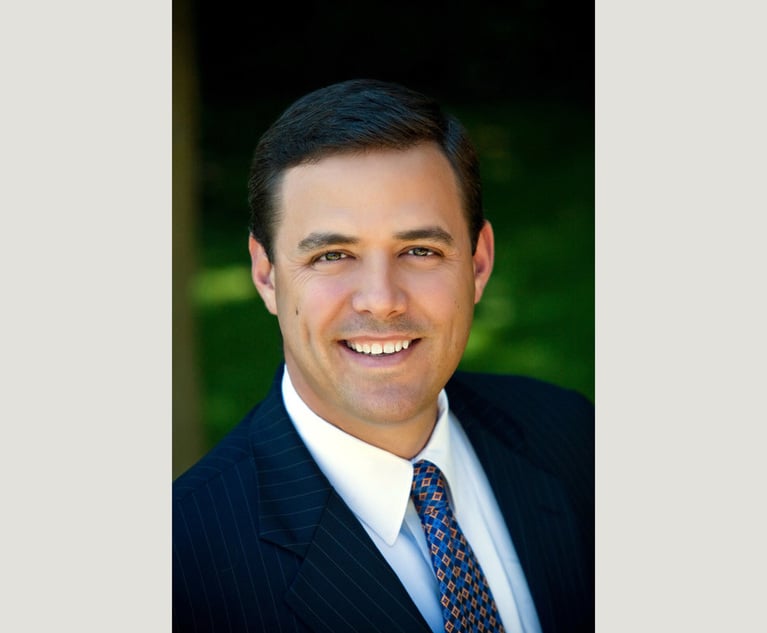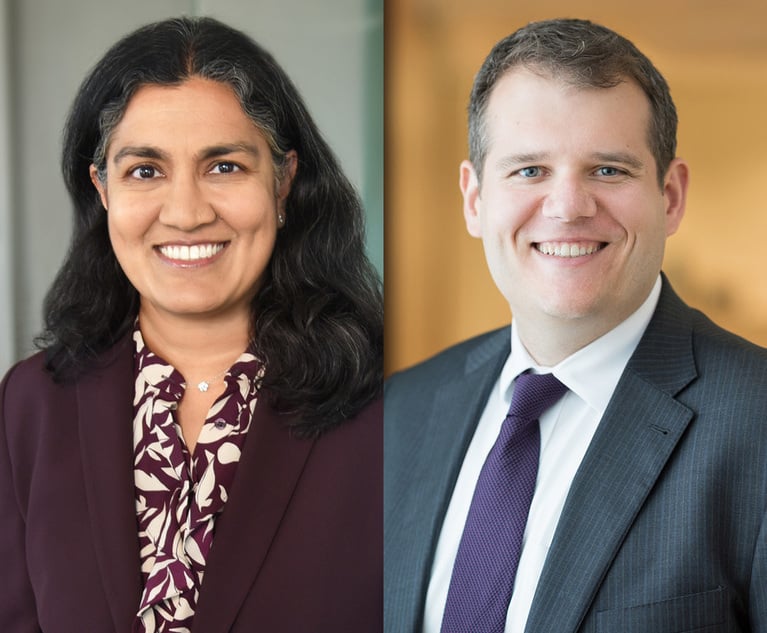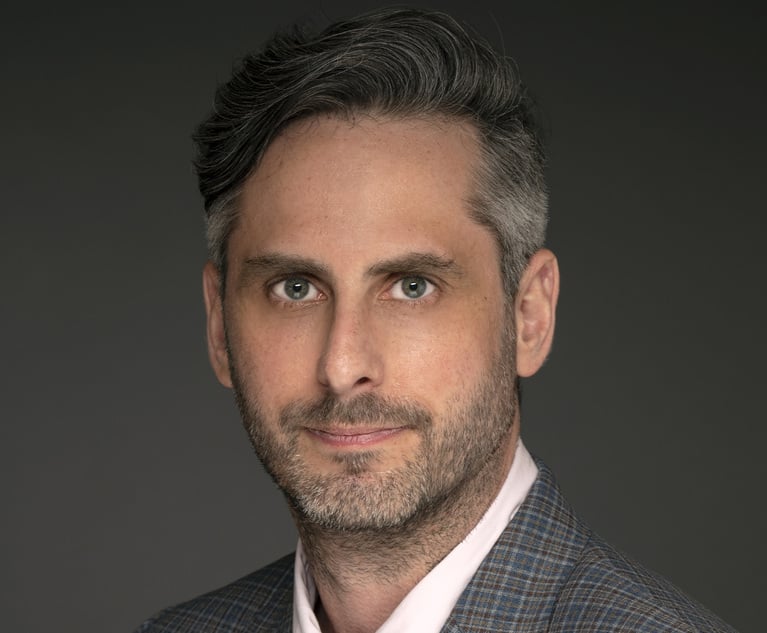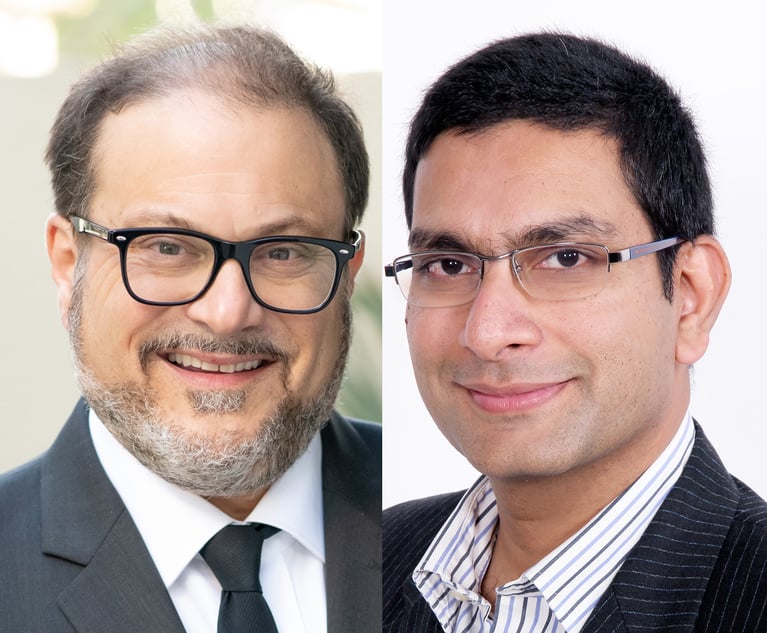Coming Soon to a Courtroom Near You? What Lawyers Should Know About Deepfake Videos
Are rules that guard against forged or tampered evidence enough to prevent deepfake videos from making their way into court cases?
March 14, 2019 at 03:49 PM
10 minute read
The following Q&A is an excerpt from Law.com's What's Next briefing, a weekly newsletter on the future of law. Click here to learn more.
If you follow technology, it's likely you're in a panic over deepfakes—altered videos that employ artificial intelligence and are nearly impossible to detect. Or else you're over it already. For lawyers, a better course may lie somewhere in between.
Riana Pfefferkorn, associate director of surveillance and cybersecurity at Stanford Law School's Center for Internet and Society, has thought about the issue of deepfake technology and the complications it raises for the introduction of video evidence in court. She's written on the topic for NW Lawyer, a publication of the Washington State Bar Association.
We asked Pfefferkorn, who's also a former Wilson Sonsini associate, to explain (sans the alarmist rhetoric) why litigators and judges should have deepfake technology on their radar.
➤ How long have you been focused on the phenomenon of deepfake videos? What is it about deepfakes that most interests you?
Riana Pfefferkorn: I first got interested in deepfakes in the spring of 2018, when I was co-teaching a course on cybersecurity law and policy at Stanford. The other two instructors were a professor of computer science named Dan Boneh and a fellow at the Hoover Institution, Andrew Grotto, who used to be a top cybersecurity policy official at the White House. The two of them had been working on a paper together about deepfakes, and they talked about that during our final session of class.
That piqued my interest, because deepfakes get at a concept that is very important in both encryption and cybersecurity more generally: authentication. How can I trust that the person I think I'm chatting with over a messaging app is in fact that person and not an interloper? How can I trust that a piece of information I'm retrieving from a database is accurate and correct, and wasn't tampered with at some point before I pulled it? And what kind of proof will satisfy me, depending on the context? That will be different if I'm acting as a fact-finder in a criminal case in court, versus if I'm just casually texting with a friend.
➤ In an upcoming issue of NWLawyer, you write about the evidentiary issues that will emerge if deepfake videos make their way into court cases. What led you to consider those implications?
At the same time as I was co-teaching this class last spring, there were two new additions to Federal Rule of Evidence 902: FRE 902(13) and (14), which had gone into effect at the end of 2017. They're both about that same concept, authentication—specifically, of electronically-stored information (ESI). And by and large I think those amendments are going to do a lot to streamline the admission of electronic evidence. But Professor Boneh taught the class that methods of digitally authenticating videos, such as through watermarking or cryptographic signatures, are still susceptible to manipulation. So, when I got up to talk about Rules 902(13) and (14), I cautioned the students that these new amendments will not be a magic bullet to keep deepfakes from creeping into evidence.
Before coming to Stanford, I spent several years as a litigation associate at a large law firm, and before that I clerked for a magistrate judge. So even though I'm now in this more academic role, I'm still interested in the nuts and bolts of pre-trial and trial practice. I find procedural issues fascinating. And that's what really grabbed me about deepfakes: How are we going to deal with them when parties start trying to introduce them into evidence in court? Are the rules courts have developed over the years to guard against forged or tampered evidence, from handwritten documents to digital photographs, going to hold up? Or are we going to need new rules?
➤ You point to a number of challenges for courts “in the not-too distant future” if deepfake videos make their way into litigation. How fast is that future approaching and do you think litigators and judges are sufficiently alert to these issues?
The verisimilitude of AI-generated photo and video seems to be growing by leaps and bounds on a near-daily basis. AI is now capable of generating fake human faces in which I for one cannot detect any tell-tale signs that it's not a real photo. So I think that future is probably coming, maybe not this year, but definitely in the next couple of years. The tools for making deepfakes are becoming ever more sophisticated. Right now the most impressive AI-generated images and video are coming from academic teams and teams at big companies — places with deep resources to devote to AI. But that progress will also trickle down rapidly to the deepfake tools that are available to anyone on the Internet to use for free. So the abusive applications of deepfakes, which are already happening, are only going to ramp up.
First we will probably see litigation about deepfakes, where the plaintiff is someone who's been victimized by a video purporting to depict her saying or doing something she didn't do, and she's trying to recover under some tort theory. But with the advances in free, readily-available tools, I think in the next couple years we'll also see deepfakes creeping into run-of-the-mill cases. In those cases, the deepfake won't be the basis of the cause of action, it'll be just another piece of evidence in the case. That's been true of social media: evidence from social media now plays a part in a wide array of cases, not just cases that are about social media platforms (e.g. cyberbullying). I think it will be true of deepfakes too.
I definitely don't think litigators and judges are thinking about these issues sufficiently yet. But we should be getting ready, while we still have a little lead time before deepfakes start cropping up everywhere. That's where I'm planning to go next in my work on deepfakes: developing practical guidelines and suggestions for how courts should go about the task of rooting out deepfake evidence, what the dos and don'ts are for litigators as they're collecting evidence for their case, and maybe also the role of expert witnesses. Experts are yet another part of the picture of deepfakes in the courtroom. This is such a cutting-edge issue that there are only a few people who right now are qualified enough to give expert opinions as to whether or not something is a deepfake. If deepfakes come up in enough cases, that handful of individuals are going to be in very high demand. So in addition to the need for lawyers and judges to prepare, I also foresee an issue with the expert pipeline.
➤ With the rise of deepfakes, do you see a risk that jurors may discount authentic video and audio evidence?
Yes. Once a video has been authenticated and the court has admitted it into evidence, it's for the jury to decide how much weight to give it, and the opposing party may make arguments to try to minimize its weight. I think juries may be more easily persuaded by such arguments now, in the age of “fake news,” than they might have been in the past, thanks to public awareness of the deepfakes phenomenon.
We might even see a kind of “reverse CSI effect,” where juries may expect the proponent of a piece of video or audio evidence to employ a lot of high-tech bells and whistles to persuade them that real evidence is not fake, even after it's been admitted. But that's expensive and time-consuming, and that shouldn't be what it takes to get juries to keep believing what's real is real. Right now in my research on this topic, I'm thinking through other options, such as whether the proponent could ask for a jury instruction (and expect it to be heeded).
With that said, the public has also been aware of other kinds of fakery, such as forged signatures and Photoshopped images, and those didn't lead to total nihilism by juries that it's possible to know what's real. So my hope is that both judges and juries will take deepfakes in stride. Time will tell.
➤ Aside from the litigation context, where do you anticipate that practicing lawyers may encounter deepfakes?
Wherever videos come into play, that's a chance for deepfakes to become an issue. And that means a range of practice areas. For example, say you are an M&A lawyer doing due diligence on a possible deal between your client and another company. If a fake video surfaces that seems to show the company's CEO making racist or sexist remarks, or stating that the company's marquee product does not work as well as advertised, that could influence your client's decision about whether to go forward with the deal. For corporations, the well-timed release of a deepfake video could mess with a lot of business dealings, attract regulator attention, hinder investment and recruiting, and anger shareholders.
The problems aren't limited to the corporate context. In employment matters, a deepfake video might lead to an employee's termination, or cause a job candidate not to be hired. Think, too, of matters of death and incapacity. In a will contest, for example, a deepfake video might be used to persuade the probate court that the decedent was, or was not, of sound mind at the time of the will signing. Or, someone might fall into a persistent vegetative state without having an advance health care directive in place. If there is a dispute among her loved ones about what her wishes would have been, a fake video might affect the dispute by supposedly depicting her talking about what she wanted.
We can foresee a range of legal settings in which deepfakes might come up, and they won't be limited to the litigation context. That means attorneys of all stripes need to be thinking about the role video recordings play in their practice and how deepfakes might affect that.
➤ We hope you enjoyed this excerpt from What's Next. View the briefing archive.
This content has been archived. It is available through our partners, LexisNexis® and Bloomberg Law.
To view this content, please continue to their sites.
Not a Lexis Subscriber?
Subscribe Now
Not a Bloomberg Law Subscriber?
Subscribe Now
NOT FOR REPRINT
© 2025 ALM Global, LLC, All Rights Reserved. Request academic re-use from www.copyright.com. All other uses, submit a request to [email protected]. For more information visit Asset & Logo Licensing.
You Might Like
View All
How I Made Office Managing Partner: 'Stay Focused on Building Strong Relationships,' Says Joseph Yaffe of Skadden

US Patent Innovators Can Look to International Trade Commission Enforcement for Protection, IP Lawyers Say

How the Deal Got Done: Sidley Austin and NWSL Angel City Football Club/Iger
Trending Stories
Who Got The Work
J. Brugh Lower of Gibbons has entered an appearance for industrial equipment supplier Devco Corporation in a pending trademark infringement lawsuit. The suit, accusing the defendant of selling knock-off Graco products, was filed Dec. 18 in New Jersey District Court by Rivkin Radler on behalf of Graco Inc. and Graco Minnesota. The case, assigned to U.S. District Judge Zahid N. Quraishi, is 3:24-cv-11294, Graco Inc. et al v. Devco Corporation.
Who Got The Work
Rebecca Maller-Stein and Kent A. Yalowitz of Arnold & Porter Kaye Scholer have entered their appearances for Hanaco Venture Capital and its executives, Lior Prosor and David Frankel, in a pending securities lawsuit. The action, filed on Dec. 24 in New York Southern District Court by Zell, Aron & Co. on behalf of Goldeneye Advisors, accuses the defendants of negligently and fraudulently managing the plaintiff's $1 million investment. The case, assigned to U.S. District Judge Vernon S. Broderick, is 1:24-cv-09918, Goldeneye Advisors, LLC v. Hanaco Venture Capital, Ltd. et al.
Who Got The Work
Attorneys from A&O Shearman has stepped in as defense counsel for Toronto-Dominion Bank and other defendants in a pending securities class action. The suit, filed Dec. 11 in New York Southern District Court by Bleichmar Fonti & Auld, accuses the defendants of concealing the bank's 'pervasive' deficiencies in regards to its compliance with the Bank Secrecy Act and the quality of its anti-money laundering controls. The case, assigned to U.S. District Judge Arun Subramanian, is 1:24-cv-09445, Gonzalez v. The Toronto-Dominion Bank et al.
Who Got The Work
Crown Castle International, a Pennsylvania company providing shared communications infrastructure, has turned to Luke D. Wolf of Gordon Rees Scully Mansukhani to fend off a pending breach-of-contract lawsuit. The court action, filed Nov. 25 in Michigan Eastern District Court by Hooper Hathaway PC on behalf of The Town Residences LLC, accuses Crown Castle of failing to transfer approximately $30,000 in utility payments from T-Mobile in breach of a roof-top lease and assignment agreement. The case, assigned to U.S. District Judge Susan K. Declercq, is 2:24-cv-13131, The Town Residences LLC v. T-Mobile US, Inc. et al.
Who Got The Work
Wilfred P. Coronato and Daniel M. Schwartz of McCarter & English have stepped in as defense counsel to Electrolux Home Products Inc. in a pending product liability lawsuit. The court action, filed Nov. 26 in New York Eastern District Court by Poulos Lopiccolo PC and Nagel Rice LLP on behalf of David Stern, alleges that the defendant's refrigerators’ drawers and shelving repeatedly break and fall apart within months after purchase. The case, assigned to U.S. District Judge Joan M. Azrack, is 2:24-cv-08204, Stern v. Electrolux Home Products, Inc.
Featured Firms
Law Offices of Gary Martin Hays & Associates, P.C.
(470) 294-1674
Law Offices of Mark E. Salomone
(857) 444-6468
Smith & Hassler
(713) 739-1250









